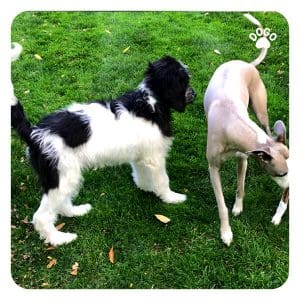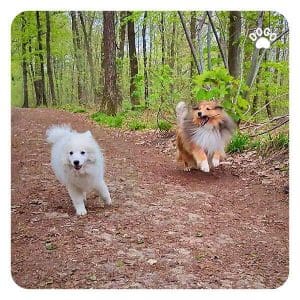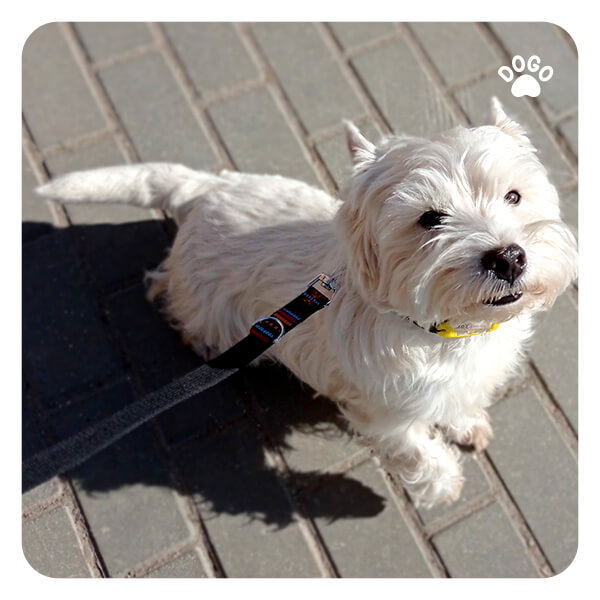“He’s wagging his tail; that means he’s happy.” How often do you come across this statement? It shows how few people can actually read their dog’s communication correctly. There are as many dogs as different tails; that’s why messages sent by dogs must be read, taking into account their breed and natural body structure. Over the years of evolution, many different breeds have been created, and some have straight tails, others curled to the back. In addition, some dogs carry their tails relatively high, while others prefer to carry their tails low. So without knowing the differences between dog breeds, it’s easy to make mistakes in reading their signals.
A dog’s tail position can express a whole range of emotions. The tail’s wagging can indicate joy, but it can also express anxiety, fear, confidence, or announce an attack. Scientists have shown that dogs do not wag their tails when they are alone in a room, no matter what emotions they are feeling at the moment. By moving their tails, dogs want to communicate a particular message to the viewer.
Tail High
 In general, we can say that a high raised tail indicates confidence. The more intensely a pooch wags their tail high, the more excited and ready for action they are. The high tail position also helps spread scents from the perianal glands, essential for canine communication.
In general, we can say that a high raised tail indicates confidence. The more intensely a pooch wags their tail high, the more excited and ready for action they are. The high tail position also helps spread scents from the perianal glands, essential for canine communication.
A stiff, high raised tail or one when the dog makes small, short, and quick movements is a warning of an attack.
For example, a dog with a stiff, high raised tail may be warning a stranger to stay away from their territory. Similarly, a dog making small, short, and quick movements with their tail may be indicating that they feel threatened and are about to attack. In both cases, it’s essential to give the dog some space and avoid provoking them further.
Tail in a Neutral Position
The neutral dog’s tail position is when the tail is at the level of the back. It indicates that the dog is calm and relaxed. Free and sweeping movements of the tail indicate happiness. It is this wagging that signifies a dog’s joy. When a dog is happy, their whole body often waggles together with their tail. It can be seen, for example, when greeting the owner. The body is then relaxed.
If the dog’s tail is in a neutral position, but it is stiff, and their movements are slow, the dog is alert and a little uncertain. This message may be sent when your dog has heard, seen, or smelled something that makes them anxious or curious.
Tail Low
 A low wagging tail indicates that your dog is scared. A slightly lowered tail position combined with a light sideways wagging may indicate a submissive dog. A low wagging tail usually means that the dog is not confident, anxious, or scared. Often, very frightened dogs tuck their tail under themselves and press them between their hind legs to avoid spreading the scent, which communicates that the dog is stressed. Waving the tail so low doesn’t mean that dog is happy to see us and wants us to pet them. An attempt to pet the dog, especially by a stranger, may result in an attack if the dog does not trust the person.
A low wagging tail indicates that your dog is scared. A slightly lowered tail position combined with a light sideways wagging may indicate a submissive dog. A low wagging tail usually means that the dog is not confident, anxious, or scared. Often, very frightened dogs tuck their tail under themselves and press them between their hind legs to avoid spreading the scent, which communicates that the dog is stressed. Waving the tail so low doesn’t mean that dog is happy to see us and wants us to pet them. An attempt to pet the dog, especially by a stranger, may result in an attack if the dog does not trust the person.
If you encounter a dog with a low wagging tail, it’s crucial to approach them slowly and calmly. Any sudden movements or loud noises may scare the dog and provoke them to attack. You should avoid direct eye contact with the dog, as this can be seen as a threat. Instead, try to turn your body to the side and speak to the dog in a calm and soothing tone. If the dog continues to show signs of fear or aggression, it’s best to back away slowly and leave the area.
Wagging Direction
Scientists have shown that positive stimuli that a dog looks forward to, such as seeing their parent, activate the brain’s left hemisphere and cause the tail to wag more to the right. Negative stimuli that the dog wants to avoid, such as the appearance of a threatening stranger, activate the right hemisphere of the brain and make them wag the tail more to the left. Other dogs can read this asymmetry perfectly.
Dogs have a keen sense of smell and can detect even the slightest changes in their environment. They can sense positive stimuli, such as the smell of their favorite food or the sight of their owner, which activates the left hemisphere of their brain. On the other hand, negative stimuli, such as the presence of a threatening stranger, activates the right hemisphere of their brain. This triggers the dog to wag their tail more to the left, indicating that they want to avoid the situation. By paying attention to the wagging direction, you can get a better understanding of what your dog is feeling and respond accordingly.
Tail Docking
Some dogs have had their tails deliberately clipped to make them look more threatening, making them much more challenging to communicate with. When reading the signals sent by a dog with a cropped tail, it is a good idea to look at the base of the tail. Even with a short tail, you can see if the dog is lifting it slightly or trying to push it under.
Since 2012, clipping dogs’ tails or cropping their ears is illegal in Poland and is classified as animal abuse. However, unfortunately in other countries, this custom is still being repeated, which to some extent impairs a dog’s communication.
Tail docking is a cruel and unnecessary practice that involves cutting off a dog’s tail for cosmetic reasons. This procedure can cause severe pain and discomfort to the dog and can lead to long-term health problems. Additionally, it impairs a dog’s communication skills, as the tail is an essential part of their body language. Without a tail, dogs may have difficulty expressing their emotions and communicating with other dogs. This can result in misunderstandings and conflicts with other dogs, which can be dangerous for both the dog and their owner.
Summary
 In reading the tail wagging messages, the tail’s position, the speed of wagging, and the direction of these movements are essential. You should not overlook the posture of your dog’s whole body and the messages sent out by their mouth, ears, eyes. Your dog’s behavior should always be read as a whole. Focusing only on the tail does not give you all the information.
In reading the tail wagging messages, the tail’s position, the speed of wagging, and the direction of these movements are essential. You should not overlook the posture of your dog’s whole body and the messages sent out by their mouth, ears, eyes. Your dog’s behavior should always be read as a whole. Focusing only on the tail does not give you all the information.
[/fusion_text]



